Asher Metzger
Google Research, Tel-Aviv, Israel
AI Increases Global Access to Reliable Flood Forecasts
Aug 10, 2023



Abstract:Floods are one of the most common and impactful natural disasters, with a disproportionate impact in developing countries that often lack dense streamflow monitoring networks. Accurate and timely warnings are critical for mitigating flood risks, but accurate hydrological simulation models typically must be calibrated to long data records in each watershed where they are applied. We developed an Artificial Intelligence (AI) model to predict extreme hydrological events at timescales up to 7 days in advance. This model significantly outperforms current state of the art global hydrology models (the Copernicus Emergency Management Service Global Flood Awareness System) across all continents, lead times, and return periods. AI is especially effective at forecasting in ungauged basins, which is important because only a few percent of the world's watersheds have stream gauges, with a disproportionate number of ungauged basins in developing countries that are especially vulnerable to the human impacts of flooding. We produce forecasts of extreme events in South America and Africa that achieve reliability approaching the current state of the art in Europe and North America, and we achieve reliability at between 4 and 6-day lead times that are similar to current state of the art nowcasts (0-day lead time). Additionally, we achieve accuracies over 10-year return period events that are similar to current accuracies over 2-year return period events, meaning that AI can provide warnings earlier and over larger and more impactful events. The model that we develop in this paper has been incorporated into an operational early warning system that produces publicly available (free and open) forecasts in real time in over 80 countries. This work using AI and open data highlights a need for increasing the availability of hydrological data to continue to improve global access to reliable flood warnings.
Flood forecasting with machine learning models in an operational framework
Nov 04, 2021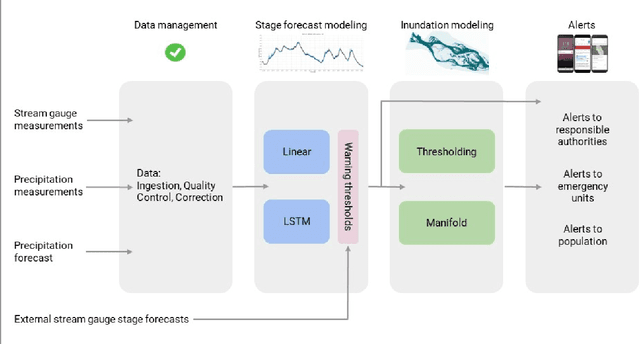
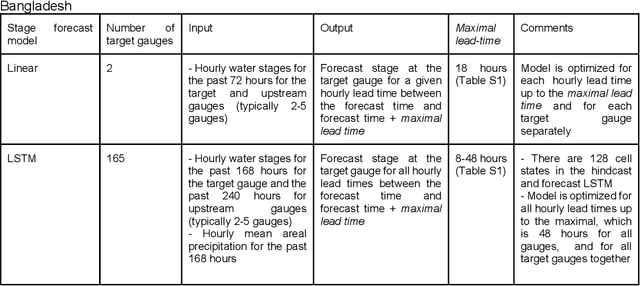
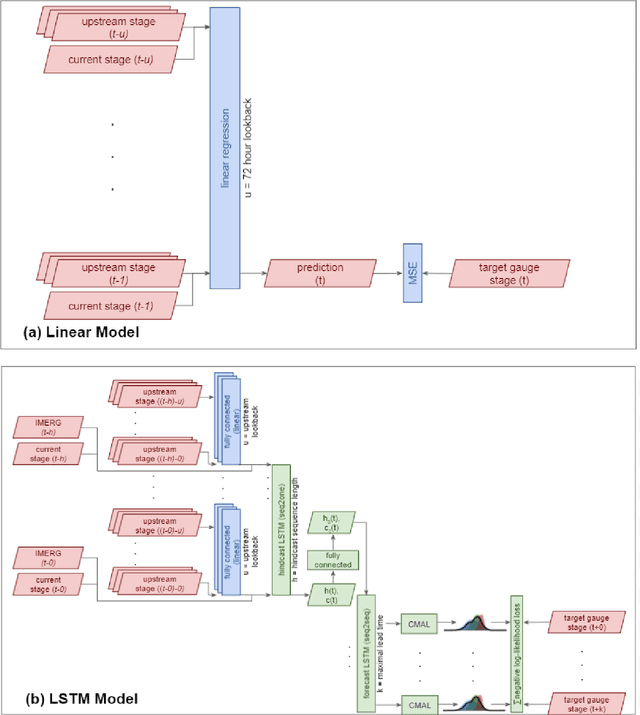
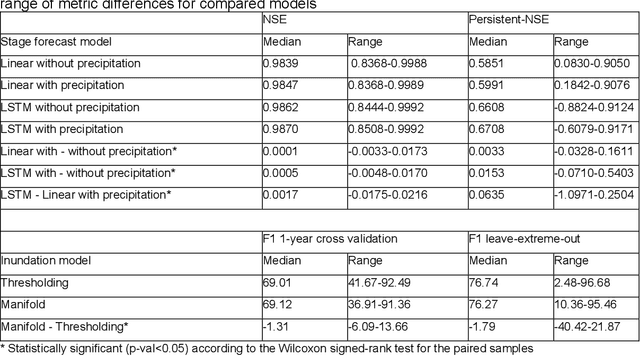
Abstract:The operational flood forecasting system by Google was developed to provide accurate real-time flood warnings to agencies and the public, with a focus on riverine floods in large, gauged rivers. It became operational in 2018 and has since expanded geographically. This forecasting system consists of four subsystems: data validation, stage forecasting, inundation modeling, and alert distribution. Machine learning is used for two of the subsystems. Stage forecasting is modeled with the Long Short-Term Memory (LSTM) networks and the Linear models. Flood inundation is computed with the Thresholding and the Manifold models, where the former computes inundation extent and the latter computes both inundation extent and depth. The Manifold model, presented here for the first time, provides a machine-learning alternative to hydraulic modeling of flood inundation. When evaluated on historical data, all models achieve sufficiently high-performance metrics for operational use. The LSTM showed higher skills than the Linear model, while the Thresholding and Manifold models achieved similar performance metrics for modeling inundation extent. During the 2021 monsoon season, the flood warning system was operational in India and Bangladesh, covering flood-prone regions around rivers with a total area of 287,000 km2, home to more than 350M people. More than 100M flood alerts were sent to affected populations, to relevant authorities, and to emergency organizations. Current and future work on the system includes extending coverage to additional flood-prone locations, as well as improving modeling capabilities and accuracy.
HydroNets: Leveraging River Structure for Hydrologic Modeling
Jul 01, 2020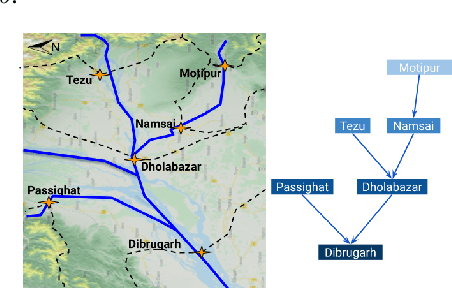
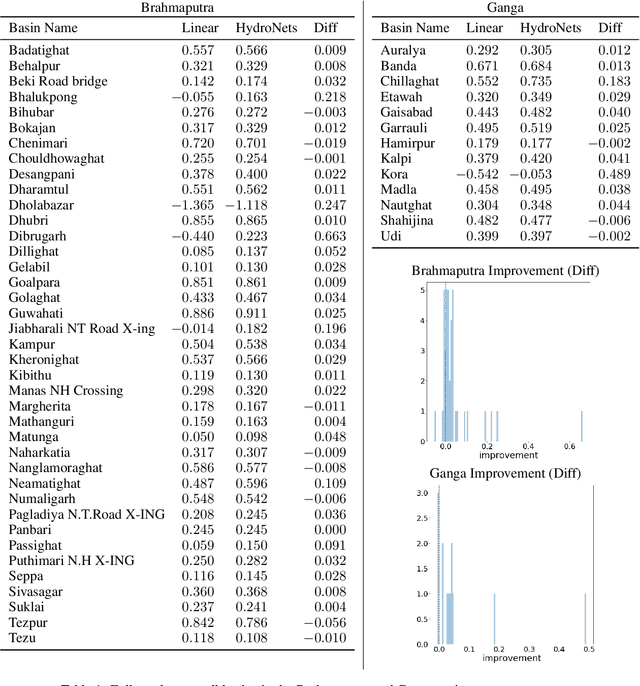
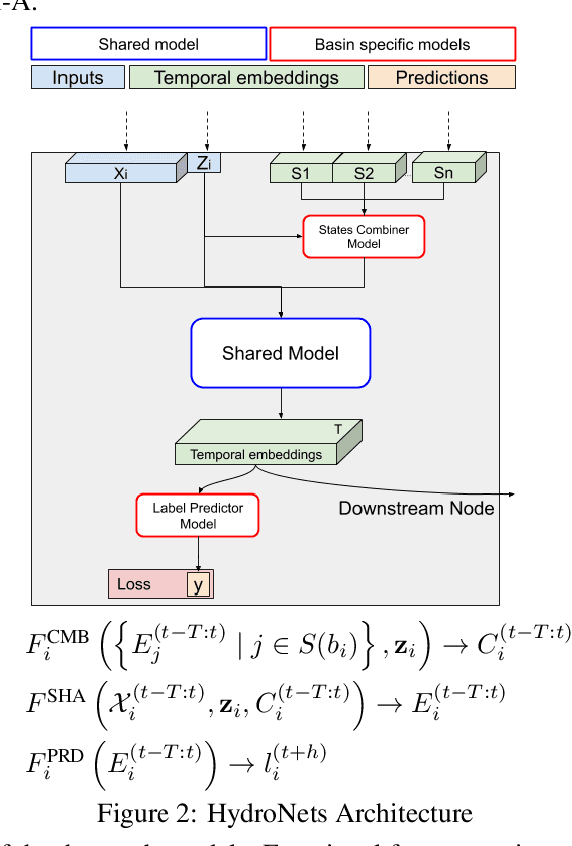

Abstract:Accurate and scalable hydrologic models are essential building blocks of several important applications, from water resource management to timely flood warnings. However, as the climate changes, precipitation and rainfall-runoff pattern variations become more extreme, and accurate training data that can account for the resulting distributional shifts become more scarce. In this work we present a novel family of hydrologic models, called HydroNets, which leverages river network structure. HydroNets are deep neural network models designed to exploit both basin specific rainfall-runoff signals, and upstream network dynamics, which can lead to improved predictions at longer horizons. The injection of the river structure prior knowledge reduces sample complexity and allows for scalable and more accurate hydrologic modeling even with only a few years of data. We present an empirical study over two large basins in India that convincingly support the proposed model and its advantages.
Accurate Hydrologic Modeling Using Less Information
Nov 21, 2019
Abstract:Joint models are a common and important tool in the intersection of machine learning and the physical sciences, particularly in contexts where real-world measurements are scarce. Recent developments in rainfall-runoff modeling, one of the prime challenges in hydrology, show the value of a joint model with shared representation in this important context. However, current state-of-the-art models depend on detailed and reliable attributes characterizing each site to help the model differentiate correctly between the behavior of different sites. This dependency can present a challenge in data-poor regions. In this paper, we show that we can replace the need for such location-specific attributes with a completely data-driven learned embedding, and match previous state-of-the-art results with less information.
 Add to Chrome
Add to Chrome Add to Firefox
Add to Firefox Add to Edge
Add to Edge